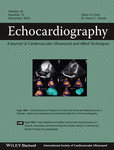Journal list menu
Export Citations
Download PDFs
Issue Information
ISCU News
Original Investigations
The Relationship between Epicardial Fat Thickness and Endothelial Dysfunction in Type I Diabetes Mellitus
- Pages: 1745-1753
- First Published: 27 April 2015
Ratio of Acceleration Time to Ejection Time for Assessing Aortic Stenosis Severity
- Pages: 1754-1761
- First Published: 22 May 2015
Importance of End-Diastolic Rather than End-Systolic Right Atrial Size in Chronic Pulmonary Hypertension
- Pages: 1762-1770
- First Published: 20 June 2015
Aortic and Mitral Calcification Is Marker of Significant Carotid and Limb Atherosclerosis in Patients with First Acute Coronary Syndrome
- Pages: 1771-1777
- First Published: 29 June 2015
The Value of Quality Improvement Process in the Detection and Correction of Common Errors in Echocardiographic Hemodynamic Parameters in a Busy Echocardiography Laboratory
- Pages: 1778-1789
- First Published: 01 June 2015
Intervendor Variabilities of Left and Right Ventricular Myocardial Velocities among Three Tissue Doppler Echocardiography Systems
- Pages: 1790-1801
- First Published: 29 April 2015
Assessment of Left Atrial Function in Patients with Celiac Disease
- Pages: 1802-1808
- First Published: 28 April 2015
Changes in Right Ventricular Shape and Deformation Following Coronary Artery Bypass Surgery—Insights from Echocardiography with Strain Rate and Magnetic Resonance Imaging
- Pages: 1809-1820
- First Published: 25 May 2015
Characteristics of Left Atrial Deformation Parameters and Their Prognostic Impact in Patients with Pathological Left Ventricular Hypertrophy: Analysis by Speckle Tracking Echocardiography
- Pages: 1821-1830
- First Published: 08 May 2015
Continuing Medical Education Activity in Echocardiography
- Page: 1831
- First Published: 07 December 2015
CME
Reference Values for Real Time Three-Dimensional Echocardiography–Derived Left Ventricular Volumes and Ejection Fraction: Review and Meta-Analysis of Currently Available Studies
- Pages: 1841-1850
- First Published: 06 June 2015
Research from or in Collaboration with the University of Alabama at Birmingham
Incremental Value of Live/Real Time Three-Dimensional over Two-Dimensional Transesophageal Echocardiography in the Assessment of Atrial Septal Pouch
- Pages: 1858-1867
- First Published: 11 November 2015
Review Article
Coronary Artery Fistula-Associated Endocarditis: Report of Two Cases and a Review of the Literature
- Pages: 1868-1872
- First Published: 06 September 2015
Challenging Cases
Simultaneous Right and Left Atrial Appendage Thrombus in a Patient with Atrial Fibrillation: A Lesson to Remember
- Pages: 1873-1875
- First Published: 02 September 2015
CASE REPORTS Section Editor: Brian D. Hoit, M.D.
Oral Everolimus for Treatment of a Giant Left Ventricular Rhabdomyoma in a Neonate—Rapid Tumor Regression Documented by Real Time 3D Echocardiography
- Pages: 1876-1879
- First Published: 22 July 2015
The authors report on rapid tumor regression of a giant rhabdomyoma with Everolimus treatment documented by three-dimensional echocardiography.
Discordant Electrocardiogram Left Ventricular Wall Thickness and Strain Findings in Influenza Myocarditis
- Pages: 1880-1884
- First Published: 01 August 2015
A 42-year-old man presented with a viral prodrome and tested positive for influenza A. He rapidly deteriorated developing cardiogenic shock, rhabdomyolysis and acute kidney injury. Patient improved 1 week later with supportive measures including vasopressors, inotropes and an intraaortic balloon pump. We report this case as it highlights the discordance between echocardiographic ventricular wall thickening as a result of myocardial edema, and electrocardiographic findings at presentation, with a reversal in findings at time of resolution. Additionally there was some suggestion of a regional pattern to the reduced longitudinal strain.
IMAGE SECTION Section Editor: Brian D. Hoit, M.D.
Giant Caseous Calcification on Tricuspid Annulus Mimicking Cardiac Metastasis in a Patient with Colon Cancer
- Pages: 1885-1886
- First Published: 22 July 2015
Caseous calcification is usually an incidental finding on the atrioventricular valvular annulus. The exact mechanism of pathogenicity for the caseous calcifications has not been defined yet. Differential diagnosis includes vegetation, thrombus, or metastatic tumors. We presented a case of a large tricuspid mass as an incidental finding by transthoracic echocardiography in a patient with metastatic colon cancer. The distinction between caseous calcification and metastatic tumor was made based on the typical location of calcification, possible extension to the whole mitral annulus, well-defined borders, and the internal echolucent area.
Left Ventricular Side Obstructive Pannus Formation after Rheumatic Mitral Valve Replacement with Preservation of the Subvalvular Apparatus
- Pages: 1887-1888
- First Published: 07 August 2015
The preservation of the subvalvular apparatus (SVA) during mitral valve replacement (MVR) surgery due to rheumatic valve disease remains controversial. The presence of intense fibrosis and calcification in rheumatic valves may promote impingement of the pannus tissue on the prosthesis and cause obstruction of the mitral inflow tract. Here we present an obstructive left ventricular side mitral pannus tissue image in a patient who had undergone rheumatic MVR with the preservation of SVA.
Severe Aortic Regurgitation Caused by Unicuspid Aortic Valve Based on Quadricuspid Aortic Valve
- Pages: 1889-1890
- First Published: 02 August 2015
A 41-year-old man was admitted to our hospital because of shortness of breath. Two-dimensional transesophageal echocardiography revealed the presence of a horseshoe-shaped unicuspid aortic valve (UAV) with two raphes at 4 and 8 o'clock positions of the aortic leaflet, and prolapse of the noncoronary cusp. Three-dimensional transesophageal echocardiography (3DTEE) clearly showed UAV, and another raphe was observed at the 7 o'clock position of the aortic leaflet. The Bentall procedure was performed, and surgical inspection confirmed the diagnosis of UAV based on the quadricuspid aortic valve. The excised specimen of the aortic valve was remarkably similar to the findings of 3DTEE.
Reversible Regional Myocardial Ischemia in a Six-Month-Old Infant Post Arterial Switch Operation Demonstrated by Speckle Tracking Echocardiography
- Pages: 1891-1892
- First Published: 18 September 2015
We present the case of an infant with coronary artery stenosis following an arterial switch operation for transposition of the great arteries. He was demonstrated to have reversible regional myocardial ischemia using speckle tracking echocardiography (STE), which corresponded to the affected territory seen when he underwent cardiac catheterization with revascularization. This demonstrates the utility of STE in infants with regional myocardial dysfunction.




